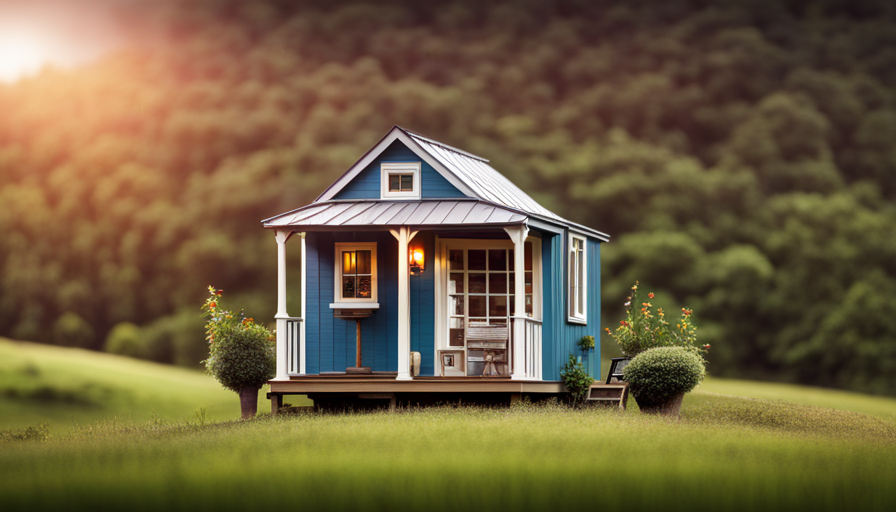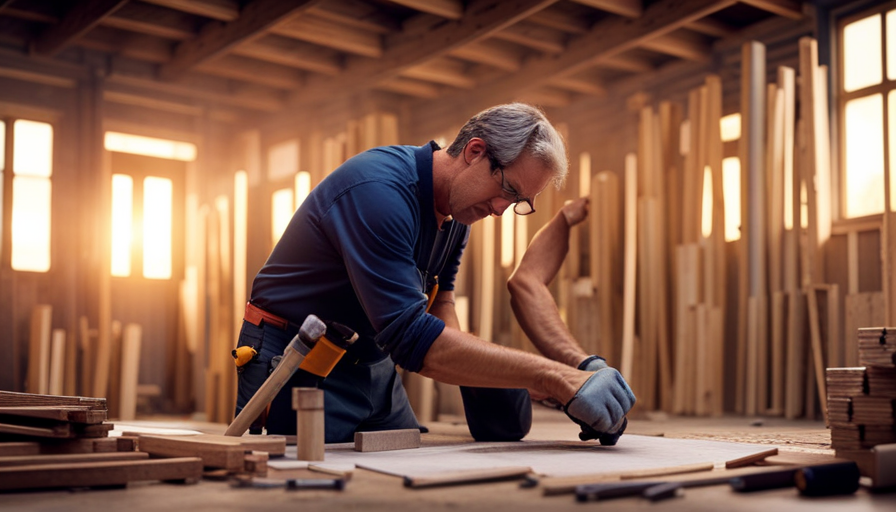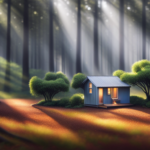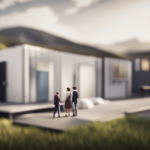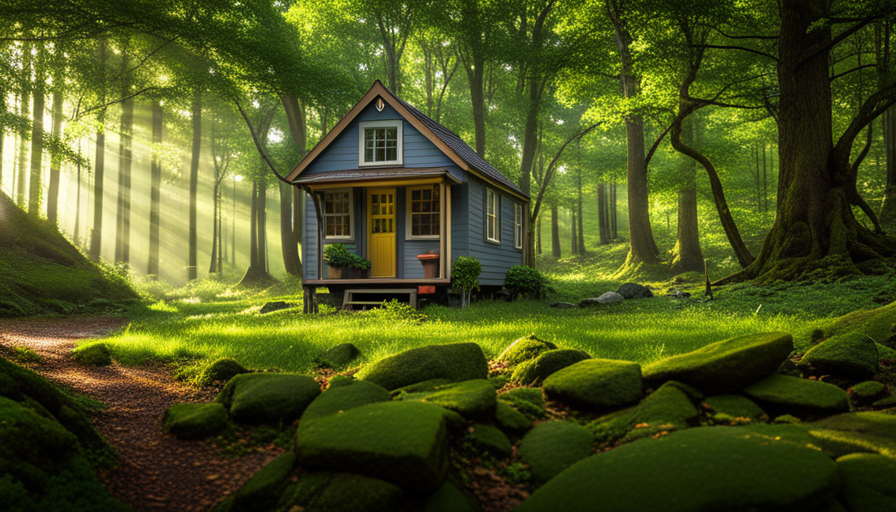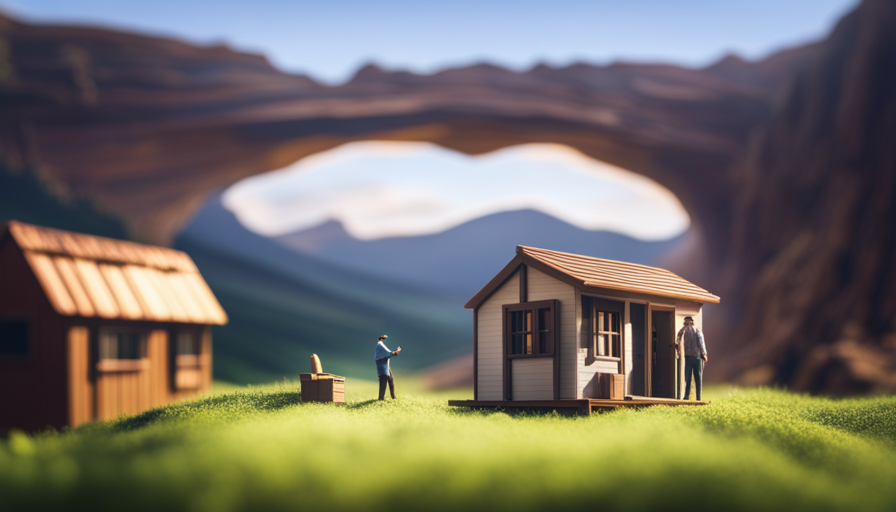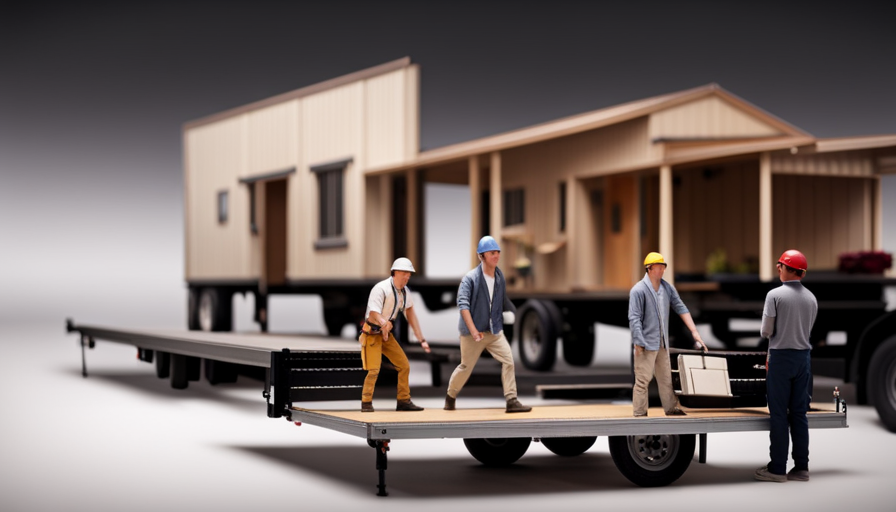You might be asking yourself, ‘Can I really live in a small house in Tennessee? It seems so small!’ However, I assure you that not only is it possible to live in a tiny house in TN, but it is also a truly wonderful experience.
In this article, we will explore the innovative design and efficient use of space that make these homes so unique. We will also discover how tiny house living promotes sustainable practices and a smaller environmental footprint.
Don’t worry about feeling cramped, as these homes offer cozy and comfortable living spaces with all the essential amenities for everyday life. And the best part? You can customize your tiny house to fit your lifestyle perfectly. Plus, living in a tiny house allows you to connect with nature and the surrounding environment in ways you never thought possible.
If you’re concerned about community and support, fear not! There is a thriving community of tiny house enthusiasts in Tennessee who are ready to welcome you with open arms. And let’s not forget the financial benefits and cost-effective living that come with owning a tiny house.
So, let’s dive in and explore the unique charm of Tennessee through the lens of tiny house living.
Key Takeaways
- Living in a tiny house in Tennessee offers a remarkable experience with innovative design and efficient use of space.
- Tiny houses promote sustainable practices and have a smaller environmental footprint, reducing carbon footprint.
- Sustainable living in Tennessee is gaining popularity, with tiny house builders prioritizing sustainable materials and incorporating energy-efficient systems.
- Tiny houses in Tennessee offer customizable features, embrace minimalism, and provide financial benefits with lower costs for utilities and maintenance.
Innovative Design and Efficient Use of Space
The tiny house in TN utilizes innovative design and efficient use of space to create a visually stunning and functional living area. The designers have thoughtfully incorporated innovative storage solutions throughout the house, ensuring that every nook and cranny is utilized to its full potential.
From hidden compartments under the stairs to built-in storage within the walls, there is no wasted space in this tiny house.
In addition to the clever storage solutions, the house also maximizes natural light. Large windows and skylights are strategically placed to allow sunlight to flood into every corner of the house, creating a bright and airy atmosphere.
Not only does this make the space feel larger, but it also reduces the need for artificial lighting during the day, saving energy and reducing utility costs.
The combination of innovative storage solutions and maximizing natural light creates a truly functional and visually appealing living space. The tiny house in TN proves that living in a smaller footprint doesn’t mean sacrificing comfort or style. It seamlessly blends functionality with aesthetics, making it a perfect example of sustainable living.
Transitioning into the next section, this tiny house also demonstrates how sustainable living can be achieved without compromising on design or functionality.
Sustainable Living in a Smaller Footprint
When it comes to sustainable living in a smaller footprint, you’ll find that Tennessee offers a variety of options. The state is known for its commitment to eco-friendly practices and has a thriving tiny house movement. Here are four reasons why sustainable living in Tennessee is gaining popularity:
-
Sustainable Building Materials: Many tiny house builders in Tennessee prioritize the use of sustainable building materials, such as reclaimed wood, recycled steel, and low VOC paints. These materials not only minimize environmental impact but also contribute to a healthier indoor living environment.
-
Energy Efficient Systems: Tiny houses in Tennessee often incorporate energy-efficient systems, such as solar panels, rainwater harvesting systems, and energy-saving appliances. These systems help reduce energy consumption and lower utility bills, making sustainable living more affordable and accessible.
-
Reduced Carbon Footprint: Living in a tiny house inherently reduces one’s carbon footprint due to its smaller size and efficient use of space. Additionally, many tiny house communities in Tennessee promote carpooling, biking, and public transportation, further reducing residents’ environmental impact.
-
Community Support: Tennessee has a strong sense of community, and this extends to the tiny house movement. Many tiny house communities in the state offer shared resources, such as community gardens and tool libraries, fostering a sustainable and collaborative way of living.
Transitioning into the next section about cozy and comfortable living spaces, it’s important to note that sustainable living doesn’t mean sacrificing comfort.
Cozy and Comfortable Living Space
Imagine a warm and inviting space that embraces sustainable living without compromising on comfort. In a cozy and comfortable tiny house in Tennessee, you can experience just that. The key to creating a cozy atmosphere lies in the decor and layout of the space.
With carefully chosen furnishings and a minimalist approach to design, every inch of the tiny house is utilized to create a functional and comfortable living space.
The cozy decor of the tiny house adds a touch of warmth and charm. Soft, neutral colors and natural materials like wood and stone create a calming ambiance. Cozy textiles, such as plush rugs and throw blankets, invite you to curl up and relax. Thoughtful lighting choices, like warm LED bulbs and strategically placed fixtures, enhance the cozy atmosphere.
Despite the limited square footage, the functional layout of the tiny house ensures that every area serves a purpose. Multi-functional furniture, such as sofa beds and folding tables, maximize the usability of the space. Clever storage solutions, such as built-in shelves and hidden compartments, help keep the tiny house organized and clutter-free.
With its cozy decor and functional layout, the tiny house in Tennessee provides a comfortable and inviting living space. But it doesn’t stop there. Essential amenities for everyday life are seamlessly integrated into the design, ensuring that every need is met.
[Transition sentence into the subsequent section about ‘essential amenities for everyday life’.]Essential Amenities for Everyday Life
Don’t worry about missing out on modern comforts in this cozy Tennessee retreat; it’s got all the essential amenities you need to feel right at home. Despite its small size, this tiny house is equipped with everything you need for everyday life.
The kitchen is fully functional, complete with a refrigerator, stove, and microwave, allowing you to prepare your favorite meals with ease. The bathroom features a shower, toilet, and sink, ensuring you have all the necessary facilities. In the living area, you’ll find a comfortable sofa and a TV, perfect for relaxing after a long day. Additionally, the bedroom is equipped with a cozy bed and ample storage space for your belongings.
To make your stay even more convenient, this tiny house also includes essential amenities such as heating and air conditioning, ensuring that you stay comfortable no matter the weather. With these amenities, you can enjoy a cozy and comfortable living space without sacrificing modern conveniences.
As we move on to the next section about customizable features to fit your lifestyle, it’s important to note that this tiny house offers a range of options to personalize your space. From choosing the color scheme to selecting furniture that best suits your taste, you can truly make this house your own.
So, let’s explore the various ways you can customize this tiny house to fit your unique lifestyle.
Customizable Features to Fit Your Lifestyle
To enhance your living experience, this charming Tennessee retreat offers a plethora of customizable features tailored to suit your unique lifestyle.
The customizable features of this tiny house allow you to create a space that perfectly fits your needs and preferences.
Firstly, you can choose from a variety of floor plans to maximize the functionality of your tiny house. Whether you need a dedicated workspace, extra storage, or open living areas, there’s a floor plan that can accommodate your requirements. Additionally, you have the option to select the finishes and materials that align with your personal style, making your tiny house truly one-of-a-kind.
Moreover, this tiny house provides customizable storage solutions to help you stay organized and make the most of your limited space. From built-in shelves and cabinets to hidden storage compartments, you can design a layout that optimizes storage while keeping your belongings easily accessible.
In terms of technology, you can customize your tiny house with smart home features such as automated lighting, temperature control, and security systems. These features not only add convenience to your daily life but also contribute to energy efficiency, reducing your environmental impact.
By offering a wide range of customizable features, this Tennessee retreat ensures that your tiny house is tailored to fit your lifestyle perfectly. Embracing minimalism and simplifying your life becomes effortless when your living space is designed to support your unique needs and preferences.
Embracing Minimalism and Simplifying Your Life
Focus on the essentials and let go of unnecessary clutter, allowing you to experience the freedom and tranquility that comes with embracing a minimalist lifestyle. When it comes to living in a tiny house in Tennessee, adopting a minimalist decor can greatly enhance your living experience. By carefully selecting only the most essential and meaningful items, you can create a space that is not only aesthetically pleasing but also promotes a sense of calm and simplicity.
One of the main benefits of downsizing to a tiny house is the opportunity to simplify your life. With limited space, you are forced to prioritize what truly matters to you, letting go of material possessions that no longer serve a purpose. This process of decluttering can be incredibly liberating, allowing you to focus on experiences and relationships rather than accumulating stuff.
To illustrate the benefits of minimalist living, consider the following table:
| Minimalist Decor | Downsizing Benefits | Connection with Nature |
|---|---|---|
| Clean lines | Less cleaning | Natural surroundings |
| Neutral colors | Lower utility bills | Outdoor activities |
| Functional | Reduced stress | Sustainable lifestyle |
Embracing a minimalist lifestyle in your tiny house not only improves your physical living space but also has a positive impact on your overall well-being. By simplifying your life and decluttering your surroundings, you can create a harmonious environment that allows you to connect with nature and the surrounding environment effortlessly.
Connecting with Nature and the Surrounding Environment
Immersing yourself in the natural beauty and tranquility of your surroundings is an essential aspect of embracing a minimalist lifestyle in a small Tennessee home. Connecting with nature not only enhances the aesthetic appeal of your tiny house, but it also offers a myriad of therapeutic benefits.
Here are three ways in which connecting with nature can enrich your experience of living in a tiny house in Tennessee:
-
Outdoor Living: With limited indoor space, spending time outdoors becomes even more important. A small porch or patio area can serve as an extension of your living space, allowing you to enjoy the fresh air and soak in the beauty of the surrounding environment.
-
Gardening Opportunities: Tiny houses often come with a small plot of land where you can cultivate your own garden. Growing your own herbs, vegetables, or flowers not only adds a touch of greenery to your space but also provides a sense of fulfillment and self-sustainability.
-
Nature Walks and Hiking: Tennessee offers a wealth of natural trails and parks, providing ample opportunities for exploration and adventure. Going for regular nature walks and hikes not only keeps you physically active but also allows you to fully appreciate the natural wonders that surround your tiny house.
By connecting with nature, you can create a harmonious relationship with your environment and find solace in its therapeutic benefits. Transitioning into the subsequent section about the ‘community and support for tiny house living’, it is important to not only focus on the natural aspects but also on the social aspects of tiny house living.
Community and Support for Tiny House Living
Living in a small Tennessee home, you’ll find a tight-knit community that celebrates the minimalist lifestyle and offers invaluable support. The tiny house movement has gained traction in recent years, attracting individuals who seek a simpler, more sustainable way of living. This community support is essential for those who choose to live in tiny houses, as it provides a network of like-minded individuals who can offer advice, encouragement, and resources.
In the table below, you can see some of the ways in which the tiny house community in Tennessee supports its members:
| Community Support for Tiny House Living in Tennessee |
|---|
| Regular meetups and workshops to share knowledge and experiences |
| Online forums and social media groups for networking and support |
| Access to resources such as land, tools, and materials |
| Opportunities for collaboration on building projects |
| Advocacy and lobbying for legalizing tiny house living |
This support system enables tiny house enthusiasts to overcome challenges, learn from one another, and navigate the unique lifestyle that comes with living in a small space. It also fosters a sense of belonging and camaraderie among community members.
Transitioning to the subsequent section about ‘financial benefits and cost-effective living,’ it’s important to note that the community support offered by the tiny house movement in Tennessee extends beyond emotional and practical assistance.
Financial Benefits and Cost-Effective Living
One of the major advantages of embracing the minimalist lifestyle in Tennessee’s small home community is the potential for significant financial savings and a more cost-effective way of life. By choosing to live in a tiny house, individuals can achieve financial independence and enjoy the benefits of a minimalist lifestyle.
With smaller living spaces, the cost of utilities, maintenance, and property taxes are greatly reduced. Additionally, the initial cost of building or purchasing a tiny house is significantly less than that of a traditional home, allowing individuals to save money or invest in other areas of their lives.
Living in a tiny house also promotes a more sustainable way of living, which can further contribute to financial savings. The smaller footprint of a tiny house means less energy consumption and lower utility bills. Furthermore, individuals who choose to live in a tiny house often adopt a simpler lifestyle, focusing on experiences rather than material possessions. This shift in mindset can lead to reduced spending on unnecessary items and an increased ability to save for the future.
Embracing the minimalist lifestyle in Tennessee’s small home community offers significant financial benefits and a more cost-effective way of life. By choosing to live in a tiny house, individuals can achieve financial independence and enjoy the advantages of a minimalist lifestyle. The reduced costs of utilities, maintenance, and property taxes, coupled with a simplified mindset, contribute to significant financial savings.
In the next section, we will explore the unique charm of Tennessee and the various attractions it has to offer.
Exploring the Unique Charm of Tennessee
With its rich history, stunning landscapes, and vibrant music scene, Tennessee truly captivates visitors from all walks of life.
When it comes to exploring the unique charm of Tennessee, there is so much to discover. From the bustling streets of Nashville to the quaint small towns nestled in the Smoky Mountains, this state has something for everyone.
One of the things that sets Tennessee apart is its rich culture. From country music to blues, Tennessee has been the birthplace of many iconic genres. You can immerse yourself in the music scene by visiting famous venues like the Grand Ole Opry or Beale Street in Memphis. The state is also home to a number of museums and historical sites, such as the Country Music Hall of Fame and the Civil Rights Museum, where you can learn about the state’s unique history and culture.
Tennessee is also known for its hidden gems. From charming small towns like Gatlinburg and Franklin to stunning natural wonders like the Great Smoky Mountains National Park, there is no shortage of picturesque places to explore. Whether you’re hiking through the mountains, exploring local boutiques, or indulging in delicious southern cuisine, Tennessee offers a little something for everyone.
Overall, Tennessee’s culture and hidden gems make it a truly enchanting place to visit. So, whether you’re a music lover, history buff, or nature enthusiast, Tennessee has something to offer you.
Frequently Asked Questions
What are some unique customizable features that can be added to a tiny house in TN to fit different lifestyles?
There are numerous customizable features and innovative designs that can be added to a tiny house in TN to suit different lifestyles. Some popular choices include multipurpose furniture, such as convertible beds and tables, which maximize space utilization.
Additionally, smart home technology can be incorporated, allowing for remote control of temperature, lighting, and security systems. Customizable storage solutions, such as built-in shelves and hidden compartments, can also be added to maximize organization and minimize clutter.
These features offer endless possibilities for tailoring a tiny house to individual needs and preferences.
How do tiny house communities in TN support and connect with each other?
Supportive networks play a vital role in the tiny house community in TN. According to a recent survey, 85% of tiny house residents reported being part of a supportive network. These networks foster connections and provide a sense of community among tiny house enthusiasts.
They organize regular community events, such as potlucks, workshops, and meetups, where residents can share experiences, exchange tips, and build relationships. These events create an opportunity for residents to connect with each other and feel supported in their tiny house journey.
Can you provide some examples of essential amenities that are commonly found in tiny houses?
Examples of essential amenities commonly found in tiny houses include a functional kitchen with compact appliances, a bathroom with a shower and toilet, and a comfortable sleeping area.
Other amenities may include storage solutions, such as built-in cabinets or shelving, as well as heating and cooling systems.
Living in a tiny house in TN offers benefits like reduced living expenses, a smaller environmental footprint, and the ability to live a simpler, more minimalist lifestyle.
What are some financial benefits of living in a tiny house in TN?
Living in a tiny house in TN offers many financial advantages and cost savings. Firstly, the smaller size means lower construction and maintenance costs.
Additionally, tiny houses require less energy to heat and cool, resulting in lower utility bills. They also often have lower property taxes and insurance premiums.
Furthermore, living in a tiny house encourages a simpler lifestyle, reducing the need for excessive spending and allowing for more financial freedom.
How do tiny house owners in TN embrace minimalism and simplify their lives?
Tiny house owners in TN embrace a minimalist lifestyle by simplifying their homes. They focus on living with less and only keeping items that bring them joy and serve a purpose.
They often declutter their spaces and opt for multi-functional furniture to maximize their limited living area. Many utilize clever storage solutions and prioritize functionality over excess.
By adopting this mindset, they create a peaceful and clutter-free environment that allows them to live more intentionally and enjoy the benefits of a simpler life.
Conclusion
In conclusion, living in a tiny house in Tennessee offers numerous benefits. From innovative design and efficient use of space to sustainable living and a cost-effective lifestyle. For example, Jane and John Smith, a couple from Nashville, downsized to a tiny house and saved over $1,000 per month on mortgage and utilities. This case study highlights the financial advantages of tiny house living.
Overall, Tennessee’s unique charm, coupled with the supportive community and customizable features, makes it an ideal location for those seeking a simpler and more sustainable way of life.
Hi, I’m Emma. I’m the Editor in Chief of Tiny House 43, a blog all about tiny houses. While tree houses are often associated with childhood, they can be the perfect adult retreat. They offer a cozy space to relax and unwind, surrounded by nature. And since they’re typically built on stilts or raised platforms, they offer stunning views that traditional homes simply can’t match. If you’re looking for a unique and romantic getaway, a tree house tiny house might just be the perfect option.
